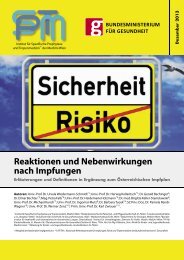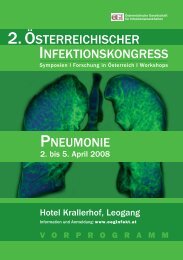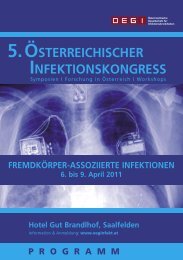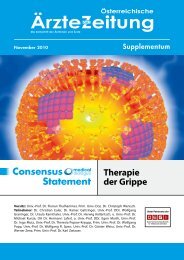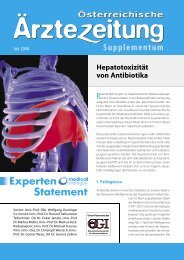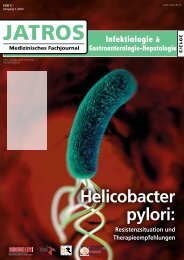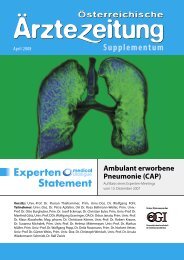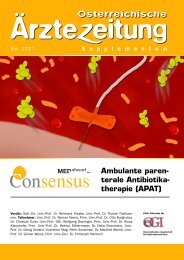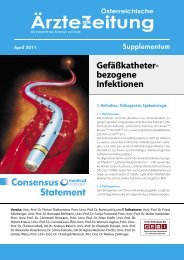Influenza: Aktuelles und State of the Art - Österreichische ...
Influenza: Aktuelles und State of the Art - Österreichische ...
Influenza: Aktuelles und State of the Art - Österreichische ...
Erfolgreiche ePaper selbst erstellen
Machen Sie aus Ihren PDF Publikationen ein blätterbares Flipbook mit unserer einzigartigen Google optimierten e-Paper Software.
JATROS Infektiologie 4 I 2011<br />
Preventing resistance<br />
The role <strong>of</strong> optimized dosing<br />
Amongst <strong>the</strong> discussed topics: resistance in <strong>the</strong> gut; resistance in a dynamic model <strong>of</strong> Streptococcus pneumonia;<br />
which matters more – antibiotic dose or <strong>the</strong> bacterium; <strong>the</strong> role <strong>of</strong> pharmacodynamics/pharmacokinetics.<br />
Resistance in <strong>the</strong> gut<br />
The rapid emergence <strong>of</strong> antibiotic resistance<br />
is a major public health concern<br />
[Zhang L et al, Appl Environ Micro -<br />
biol 2011]. Johan W. Mouton, MD,<br />
Nijmegen Institute for Infection, Inflammation<br />
& Immunity, The Ne<strong>the</strong>rlands,<br />
discussed five questions <strong>of</strong> resistant bacteria<br />
in <strong>the</strong> gut: <strong>the</strong>ir possible presence without<br />
antibiotic exposure; whe<strong>the</strong>r <strong>the</strong>re is<br />
selection <strong>of</strong> resistant gut bacteria during<br />
antimicrobial exposure; whe<strong>the</strong>r <strong>the</strong>re is<br />
selection <strong>of</strong> resis tance during systemic<br />
treatment for o<strong>the</strong>r infections; whe<strong>the</strong>r it<br />
is possible to avoid or minimize selection;<br />
and how optimization <strong>of</strong> treatment relates<br />
to selection <strong>of</strong> resistance in <strong>the</strong> gut. Data<br />
suggest that early development <strong>of</strong> antibiotic<br />
resistance in human gut microbiota is<br />
independent <strong>of</strong> an infant’s exposure to antibiotics<br />
but is likely to be affected by exposure<br />
to maternal and environmental<br />
microbes during and after delivery. The<br />
population <strong>of</strong> food-borne antibiotic-resistant<br />
bacteria is also significantly amplified<br />
within <strong>the</strong> host, even in <strong>the</strong> absence<br />
<strong>of</strong> antibiotic-selective pressure [Zhang L<br />
et al, Appl Environ Microbiol 2011].<br />
Pr<strong>of</strong>. Mouton cited a study in which 2 <strong>of</strong><br />
20 children with no known antibiotic exposure,<br />
living in a very remote Senegalese<br />
village, were fecal carriers <strong>of</strong> a multiresistant<br />
Escherichia coli clone that produced<br />
CTX-M-15 [Ruppe E et al, Antimicrob<br />
Agents Chemo<strong>the</strong>r 2009], strongly suggesting<br />
that <strong>the</strong> pC15-1a MDR region can<br />
persist in <strong>the</strong> intes -tinal flora in <strong>the</strong> absence<br />
<strong>of</strong> signifi -cant selective pressure, at<br />
least that we know <strong>of</strong>.<br />
Based on a report by de Smet et al [de<br />
Smet AM et al, Lancet Infect Dies 2011],<br />
Pr<strong>of</strong>. Mouton justified <strong>the</strong> widespread<br />
use <strong>of</strong> selective digestive tract decontamination<br />
in intensive care units with low levels<br />
<strong>of</strong> antibiotic resis tance. Pr<strong>of</strong>. Mouton<br />
presented an extensive analysis <strong>of</strong> an experimental<br />
study that looked at <strong>the</strong> effects<br />
and duration <strong>of</strong> antimicrobial treatment<br />
for pneu monia in selecting resistant<br />
micro organisms in <strong>the</strong> gut [Goessens<br />
WH et al, JAC 2007]. This showed that<br />
<strong>the</strong> more frequent <strong>the</strong> dosing regimen,<br />
<strong>the</strong> higher <strong>the</strong> propensity for selecting resistant<br />
bac teria. Emergence <strong>of</strong> resistance<br />
is dependent on dose (inverse U shape),<br />
duration <strong>of</strong> <strong>the</strong>rapy, and dosing regimen.<br />
For <strong>the</strong> first three questions that were posed<br />
in <strong>the</strong> talk, Pr<strong>of</strong>. Mouton answered<br />
“yes”; “perhaps” to <strong>the</strong> fourth; and “not<br />
good” to <strong>the</strong> fifth.<br />
Resistance in a dynamic model<br />
Didier Guillemot, MD, Institut Pasteur/<br />
Univ. Versailles Saint Quentin/Inserm,<br />
Paris, France, discussed <strong>the</strong> impact <strong>of</strong><br />
antibiotic dose on resistance selection in<br />
<strong>the</strong> community. His findings were based<br />
on a dynamic model <strong>of</strong> Streptococcus<br />
pneumoniae. His presentation covered<br />
β-lactam doses and pneumococci susceptibility,<br />
accounting for β-lactam doses.<br />
From a public health point <strong>of</strong> view, antibiotics<br />
do more to increase <strong>the</strong> clearance<br />
<strong>of</strong> susceptible bacteria than <strong>the</strong> acquisition<br />
<strong>of</strong> a new mechanism or resistant<br />
strain. Pr<strong>of</strong>. Guillemot noted that much<br />
is known about <strong>the</strong> relation between S.<br />
pneumoniae, antibiotics, and resistance<br />
but not at <strong>the</strong> population level.<br />
The ma<strong>the</strong>matical model that he discussed<br />
assessed <strong>the</strong> influence <strong>of</strong> modifying<br />
doses <strong>of</strong> β-lactam at <strong>the</strong> population<br />
level to estimate <strong>the</strong> impact on resistance<br />
levels and prevalence in colonized<br />
individuals. Questions that were considered<br />
using this model included <strong>the</strong> effects<br />
<strong>of</strong> prescription frequency, prescribed<br />
dose, and whe<strong>the</strong>r defined daily dose<br />
(DDD) is a good indicator to predict <strong>the</strong><br />
evolution <strong>of</strong> β-lactam resistance to S.<br />
pneumoniae. Simu lations over a 50-year<br />
period <strong>of</strong> fixed- and variable-dose exposure<br />
showed a bimodal distribution and<br />
that <strong>the</strong> prevalence <strong>of</strong> resistance increases<br />
with <strong>the</strong> frequency <strong>of</strong> exposure. Both findings<br />
were consistent with prior epidemiological<br />
studies.<br />
Dosing outcomes indicated that higher<br />
doses may reduce <strong>the</strong> prevalence <strong>of</strong> resistance<br />
and increase <strong>the</strong> MIC <strong>of</strong> resistant<br />
strains. The model also showed that<br />
DDD is not an accurate indicator for<br />
predicting pneumococcal resistance to<br />
β-lacams. “Don’t use any more DDD to<br />
anticipate <strong>the</strong> future <strong>of</strong> Sp. disseminaantibiotic<br />
• stress<br />
competence<br />
• transformation<br />
•<br />
•<br />
•<br />
antibiotic resistance<br />
capsule exchange<br />
Fig.: Antibiotics promote evolution <strong>of</strong> resistance<br />
I 34<br />
universimed.com




